I listened to my friend Isabelle Legeron, founder of the Raw Wine Fair, on a podcast recorded during the Wall Street Journal’s Future of Everything Festival a few weeks ago.
What struck me, was how articulate and passionate Isabelle is, correlating wine with food, transparency with change, and how we are all products of an industrial change in agriculture that is positive neither personally nor for the health of the planet.
As well, how both the panel moderator and the festival skirted the larger truth.
How the tech journalists at the festival smartly built relationships between the future of work, technological platforms for change, genomics, guaranteed basic income, robotics—and missed completely how natural wine as an artisanal endeavor fits into this picture.
That’s because it doesn’t—or maybe—does in a very different and important way.
I blogged on this to my tech community focusing on the arts and the Etsifying of crafts but didn’t place natural and hand-made wine as squarely in this camp as I should have perhaps.
In general, the mass market understands what organic means, though certification does very little to truly either educate or police this.
It is a fact that natural wine, that is made from grape juice with no additives except some SO2, is growing in popularity and influence, filling the wine lists of the best restaurants, the shelves of the best shops, and the tasting tables of festivals everywhere.
The wellness consumer, has embraced ‘natural’ in our food as correspondent with healthy and fresh, and to a lesser extent, natural in wine as something different and more personal.
But the smallest percent of people consuming the tiniest percent of wine made naturally, understand at all how wine is made or the impact of monoculture on our lives.
And I doubt ever will.
But this same population is mobbing the green markets. Overflowing festivals like Raw, and brilliant approaches to people and wine that my good friend Andre Ribeirinho and his Adegga Wine & Food Festivals brings to people across Portugal and Brazil.
This is about culture’s embrace of the personal, the artisanal, the handmade as a necessary foil to the scalability and digitization of our lives.
That is why we love our winemaking heroes in a very unique way, as friends. When we crowd into these festivals as a celebration, touching flesh with others, letting the winemakers fill our glasses, tell us stories, transport us to their vineyards in spirit and share their love of what they are doing.
This is what the WSJ festival and most everyone, is missing. How critical the artisanal is to our lives.
Making handmade wine is an economically impossible task.
You can scale organic agriculture but natural or artisanal or wine is by definition hand harvested as it is only through that task that enables not adding the host of additives to counteract the forces that would spoil it.
And as Isabelle brings out clearly, making wine this way requires patience and time.
You must give back to the natural process the cycles needed.
If you have a generational vineyard, or hark from the Priorat let’s say, where the marginal cost of land, grapes, labor is small perhaps not. If you are from Santa Barbara, Berkeley, even Portland where you can never afford land, the economics of artisanal as a business is sketchy at best.
Though more and more artisans are doing this.
And more and more of us are supporting it, paying a bit more, paying admission to fairs to lionize these artisans, combining slowly the panache of wine with the embrace of artisans in the food world.
What we all need to realize, and what the WSJ should be talking about, is not whether SO2 is naturally in all grapes but to what extent and how our culture is evolving and tech’s economizing role in it.
How in the face of crowd-sourcing and decentralizing activities of every possible type, this is happening. How we can expect autonomous solar vehicles on the streets of NYC within a decade, yet it is arguably the center of the planet for natural wine consumption.
For eons, the same discussions have been had—and still are—about the arts.
And today, post industrialized agriculture, how we can support these artisans, these winemakers not only as emblems of something wonderful, but as part of that rising change that will spill over to larger solutions to food, drink and the environment.
We need to put the smartest folks on the stage of these festivals, to think out loud about how Universal Basic Income will impact both the arts and the artisans and their role in our culture.
How ideas like tokenizing belief and intent within communities of interest like this one, make the hand-made economic through the very value it brings to the greater community and society itself.
Tech in the hands of the truly stupid was the enemy of the people and the planet in the industrialization of agriculture.
Tech communities, the ethical awareness of movements for change that comes with them are the most powerful forces for change today.
And our best shot for a richer future.
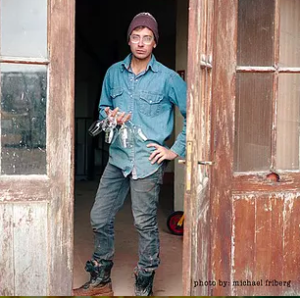
The most interesting natural wines are inextricably intertwined with the personality of the winemakers who make them.
Each bottle an origin story of sorts that fuses the natural forces at work in the vineyard, the characteristics of the grape with the intent and beliefs of the artisan that crafts it all together.
This is singularly true of Evan, founder and winemaker of Ruth Lewandowski Wines in Salt Lake City.
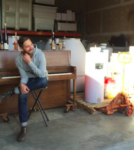 Part Rudolph Steiner romantic, part viticulturist, part dreamer of a wine culture driving sustainable agriculture in the high desert of Utah. And part, mellowed spiritualist stemming from his Catholic and Evangelical upbringing.
Part Rudolph Steiner romantic, part viticulturist, part dreamer of a wine culture driving sustainable agriculture in the high desert of Utah. And part, mellowed spiritualist stemming from his Catholic and Evangelical upbringing.
All parts though, uniquely talented, creative vigneron and artisan of handmade natural wines.
Evan’s backstory starts with working with my friend Zev Rovine, then the owner of The Spotted Frog wine bar in Park City; later the founder of Rovine Selections, one of the earliest and most influential of the boutique natural wine distributors.
That was in 2004 and started Evan, then 21, a graduate of University of Utah, on a journey of wine discovery. It took him to an internship at Ferrari-Carano, a degree in Viticulture from Walla Walla, and travels studying winemaking through Australia, New Zealand, Argentina, Italy, ending with a gig with Christian Binner at Domaine Audrey in the Village of Ammerschwihr, in Alsace, France.
A grand walkabout culminating in the founding of Ruth Lewandowsky Wines in Salt Lake City in 2012.
 My connection to this saga, started with a bottle of Evan’s Chilion that I bumped into at Chambers Street Wines. A long duration, skin-macerated, 100% Cortese grape grown at Fox Hill Vineyard in Mendocino, California and made in Salt Lake.
My connection to this saga, started with a bottle of Evan’s Chilion that I bumped into at Chambers Street Wines. A long duration, skin-macerated, 100% Cortese grape grown at Fox Hill Vineyard in Mendocino, California and made in Salt Lake.
I fell hard for this bottle.
Almost no fruit in the front palate, deeply textured, creamy, vibrant and crazily fresh. I loved it and was curious about the medley of naming and iconographic myths surrounding the bottle and the winemaker.
Here’s the thing about Evan and his wine.
There’s certainly complexity to his personal story riddled with Old Testament references to the Book of Ruth in his wineries name (Ruth Lewndowski is not his mother!), inferences of rebirth and religion, and the nomenclature of biblical characters in each of his wine’s names. Elucidating and layered but I look to the vineyard to really understand his work and intent.
After drinking many bottles of his wine. Lots of back and forths, and a long Skype with him, the guy I got to know is a down-home mythologist, a quite brilliant viticulturist who thinks more like a grower than a winemaker and embraces the patient learnings from the vagaries of the vineyard and the vines themselves as gospel.
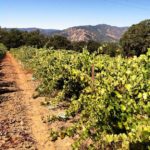 He shared the tale of the Cortese grape, the grape variety in the bottle of Chilion.
He shared the tale of the Cortese grape, the grape variety in the bottle of Chilion.
How this most scraggly of grapes in the vineyard is in a perpetual state of struggle. How the vines canopy cover is never full enough to shade the grape, so there is variable ripeness cross the clusters during harvest. Some are always exposed, some partial, some hardly at all. How Cortese’s core character is its lack of conformity, its lack of innate nutrients and an astounding low nitrogen count at harvest.
And how counter-intuitively, counter to the imagination even, the wine transforms dramatically, even gaining nitrogen during the long fermentation process.
 How loving this variety, taught him that patience is the pulse of nature, that perfection is an abstraction, that while knowledge is key to decision making, we need be open and leave room for the mystery of it all.
How loving this variety, taught him that patience is the pulse of nature, that perfection is an abstraction, that while knowledge is key to decision making, we need be open and leave room for the mystery of it all.
That the best wine is always more than the sum of its parts.
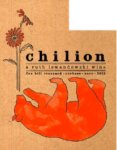 He chose the lounging, inebriated bear on the label of Chilion as an icon with folklorish purpose. How at the Fox Hill Cortese vineyard in Mendocino where the grapes are grown, before they put up deer fences, it was thought time to pick when a bear ambled by, swiped and gorged on the fruit indicating with a natural gesture, that it was time for the harvest
He chose the lounging, inebriated bear on the label of Chilion as an icon with folklorish purpose. How at the Fox Hill Cortese vineyard in Mendocino where the grapes are grown, before they put up deer fences, it was thought time to pick when a bear ambled by, swiped and gorged on the fruit indicating with a natural gesture, that it was time for the harvest
This is the origin story of this bottle of Chilion, my favorite of Evan’s wines. An exceptional bottle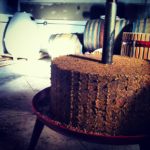 that captures the creaminess of the grape, the grip of the skin. A texture and vibrancy that stay with you long after the glass is empty.
that captures the creaminess of the grape, the grip of the skin. A texture and vibrancy that stay with you long after the glass is empty.
He started making this wine in 2012 during his first harvest with his new winery, with a 7-week skin maceration. The results were not what he dreamed of. In year two, he took a giant leap, gave himself over to the process and with 2 tons of Cortese grapes, moved to a 6-month maceration.
A long hibernation state of sorts where you pick a multi-ripe crop, crush and put in the huge eggs in Mendocino. Seal, strap in the refrigerated truck to his facility in Salt Lake City and simply wait. The results are this great bottle that inspired this post and made me rethink my preconceptions of what Cortese as a grape is all about.
Ruth Lewandowski Wines as a spontaneous happenstance is a truly intriguing mashup.
A grand vision of the power of natural wines as true expression, a reimagined wine culture in the high desert, a personal love of Utah as an outdoorsperson, a location that is alcohol unfriendly at its best, and the dedication to hunker down and work through this most unpragmatic process of wine making, growing in California, trucking to Utah after the crush till his local grapes are someday ready.
The winery opened in 2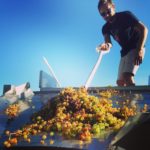 012 and made 300 cases, growing grapes in two vineyards in Mendocino. Partnering with his buddy Sam Bilbro from Idlewild Wines, crushing the grapes to start fermentation and driving the truck himself to his facility in Salt Lake.
012 and made 300 cases, growing grapes in two vineyards in Mendocino. Partnering with his buddy Sam Bilbro from Idlewild Wines, crushing the grapes to start fermentation and driving the truck himself to his facility in Salt Lake.
In 2o18 he will make around 1900 cases, adding three new Mendocino sites and moving to a commercial trucker to move the Flextank 230-gallon, polyethylene eggs to Utah.
Growing grapes in Utah?
They actually do grow some grapes in Boaz, Utah. But it is too hot, the summers to long, and not suitable for Evans dream of creating a sustainable cash crop with grapes to change the agricultural ecosystem in the high desert. And as well, supply grapes for his own wines.
He hunted down the right spot in Boulder Town, Utah, population 20, elevation 6400 feet with 18-21 inches of rain as the place to do it. The place he thinks that just maybe he can incubate a grape growing wine culture as a vigneron.
It will not happen this year, but knowing Evan, it will most certainly be done.
He is a man of profound focus and will.
A big thanks!
 A big thank you to Evan for his patience in chatting with me. To my good friend Ariana Rolich for the intro and the folks at Chambers Street Wines for tolerating my endless questions.
A big thank you to Evan for his patience in chatting with me. To my good friend Ariana Rolich for the intro and the folks at Chambers Street Wines for tolerating my endless questions.
My suggestion is to find this bottle and try it. His other wines as well.
They will certainly not disappoint and may open your eyes to a different approach that uniquely utilizes this variety to create a structured, vibrant altogether new expression of this grape. And one of the best skin-contact white wines coming out of the New World this year.
Retails around $35 generally.
Evan is a highly likable, interesting and authentic individual with not a hint of conceit to him. A talented artisan with a penchant for stories of rebirth and hope, with a generous touch that reflects itself in his opinions, his decisions, his patience and some kick-ass natural juice.
This bottle especially captures it all.
_______________________________
Chilion 2015, Fox Hill Vineyard, Mendocino, California
- 100% Cortese Grape
- 5 hectare vineyard
- Pebbly sandstone
- 17 year old vines avg
- 35 hl/ha yield
- Hand harvest
- Full skin fermentation for 6 month.
- Polyethylene egg aging
- No fining, filtration or sulfur added
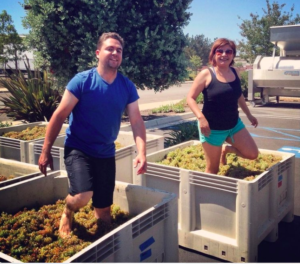
We are in the early days of a modern renaissance in the artisanal wine world.
A cross-generational melting pot of innovation spanning a dizzying array of grapes and tastes under the moniker of natural wine.
Alongside the early pioneers, there is a new generation showing up.
Less connected to tradition, defined as a group mostly through the individuality and strength of their diversity. Their unabashed vitality and optimism is layering into the wine world something fresh with a zest of personality all its own.
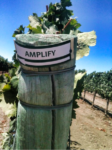 These qualities are singularly true for Cameron and Marlen Porter, co-winemakers and the couple behind Amplify Wines in Santa Barbara County.
These qualities are singularly true for Cameron and Marlen Porter, co-winemakers and the couple behind Amplify Wines in Santa Barbara County.
I met them last year at a Chambers Street Wines tasting and was seriously smitten with their Carignane, a fresh and bright, light and brilliant bottle that drinks like an homage to my beloved Poulsard from the Jura.
fresh and bright, light and brilliant bottle that drinks like an homage to my beloved Poulsard from the Jura.
It was this wine that started it for them as winemakers six years ago. It was the bottle that drew me to chronicle their story here.
They are young, both turning 34 this year. Musicians by background. Creative, expressive and thoughtful individuals by nature. Natives of Santa Barbara County by birth.
As they told their story, they grew up drinking the classic wines from Burgundy and Bordeaux but discovered that the wines they truly loved, the ones that drew them in and set their imaginations loose just happened to be natural wines.
In their early 20s, living in LA, dating and hanging out at Lou Amdur’s wine bar, Lou On Vine, they fell for those forgotten places like the Jura. Realized that natural wine is an approach, not a dogma. A platform for experimentation and creativity that they could personalize and make their own.
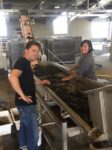 There is something original, honest, solidly earnest and focused about the two of them.
There is something original, honest, solidly earnest and focused about the two of them.
On one hand, they are truly driven by the creative expression that lets them as musicians and self-taught winemakers make wines of individual consequence reimagined through personal visions of music and art.
On the other, they are born and raised in rural Santa Barbara County, locals intimate with the details of this diverse terroir. Poetic as they describe how the transverse mountain ranges, opening to the pacific drive huge temperature shifts impacting the vines. How the uniqueness of the soil—serpentine and diatomaceous earth–is formative to the character of the place and the possibilities of the wine itself.
diverse terroir. Poetic as they describe how the transverse mountain ranges, opening to the pacific drive huge temperature shifts impacting the vines. How the uniqueness of the soil—serpentine and diatomaceous earth–is formative to the character of the place and the possibilities of the wine itself.
Amplify Wines was founded in 2013 when they scraped together savings to buy a ton of grapes, making 90 cases. Some of Carignane and a Viognier.
The mythos of their name comes from the song Amplify the Autumn from Cameron’s band Ten Teardrops. Their musical roots (he guitar player, she from a generational family of musicians from Mexico) inspired both the name of their domain and their core ethic–Wines of place, amplifying the voice of site.
They both come from the wine trade.
Cameron first in retail, then a Somm, now directing sales and hospitality for Presqui’ile Winery in Santa Maria where they make their wine. Marlen as a GM for local wineries till the birth of their son Miles in 2015.
They are self-taught artisans, learning the hard way, on a basic nuts and bolts level from working in local cellars, studying wines they fell in love with, pouring over tech sheets, winemaker interviews, old books.
They just did this. Few resources. No land owned. No vineyards leased. No facility they could call their own.
Increasing the original 90 cases in 2013 slowly to 1,000 in 2017, with the 2018 harvest, doubling to 2,000 cases while adding new varieties.
I discovered a key puzzle piece that helps me understand the narrative of their wines and the allure of their approach.
They start with an idea: For example, the love of Poulsard in the Jura from Overnoy and Puffeney and carbonic Carignan from the Roussillon.
Or the notion of removing time (vintage) from site expression tied to the idea of an endless loop from a favorite musician J. Dilla on his Donuts album.
They source maligned or obscure, late harvest grapes oozing with potential and acidity paying $2000/ton/avg. against the $25K a ton for Cab or $7-10K for Pinot in the county.
Partnering with small organic growers from Los Olivos District (Carignane, Counoise, Cabernet Sauvignon, Merlot, Riesling, Tempranillo). From Alisos Canyon (Viognier). From Santa Maria (Grenache Blanc, Refosco). (AVA map here.)
Discovering an expression that ties the idea to an approach, like partial carbonic for their Carignane or a reimagined Solera method (from Port) for their Merlot. Experiment, pull it all together and iterate over time.
Cameron and Marlen are building a wine label that represents their unique experience, expressed in singular, expertly-made and approachable wine that conveys the character of their birthplace, driven by the personality and perspective of their passion for music and art.
 I can’t recommend these wines enough.
I can’t recommend these wines enough.
They are both equally delicious, soulful expressions of their grapes and the personalities of this quite lovely and self-effacing winemaking family wrapped in Santa Barbara County as a terroir unique unto itself.
Both the Carignane ($23/bottle) and the Solera Merlot ($25/bottle) are in stock at Chambers Street Wines.
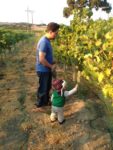 I so enjoyed getting to know the family and chronicling this story.
I so enjoyed getting to know the family and chronicling this story.
A heartfelt thanks to Cameron and Marlen for sharing so openly with me. To their beautiful son Miles who protested but tolerated me keeping him from dinner as I skyped with his parents.
To my friend Ariana Rolich and the Chambers Street team for their friendship and tolerance of my incessant questions. To Mike Foulk and the team at MFW Wines for bringing Amplify’s exceptional wines to market.
This quote from a shared hero of the three of us, Masanobu Fukuoka (One-Straw Revolution) speaks volumes to who they are and their unique take on wine.
“Natural, do nothing farming, leaves time to write a haiku, or a song.”
**All photos from Cameron and Marlen.
___________________
Winemaker Notes
2016 Carignane, Camp 4 Vineyard, Santa Ynez Valley
- The grape that started it all with 1 ton of fruit bought in ‘013, now in the seventh vintage
- Methodology:
- Semi-carbonic maceration
- Foot stomp bottom of bins with whole cluster, layer uncrushed whole cluster on top and seal, add CO2 once a day
- Carbonic varies between 1-2 weeks
- Press, finish in neutral wood, age undisturbed on lees for 5-6 months
- Racked for bottling adding 8-10ppm SO2
- Fruit is from Camp 4, planted in 1999, located on the Eastern end of the Santa Ynez Valley AVA, in the sub-AVA Los Olivos District. Hot and perfect for Carignane. Typically picked late September at potential alcohol of 13-13.5 and tons of acid (pH 3.2-3.3)
- Gravelly loam soil on VSP trellis
- Sustainably farmed. No herbicides, lots of owl and bat houses with cover crops
‘Lightworks’ Vol 1, Solera/for Dilla/For the endless loop, Santa Ynez Valley
- Evolved out of a love of old school Napa Merlot and Bordeaux
- A grape much maligned in SBC though naturally at home climate wise
- Driving idea is removing time from site expression and searching for raw material to translate the idea of an endless loop from their favorite musician J. Dilla on his Donuts album where Lightworks is the seminal track
- Solera Method: Must often thought of for port, reimagined for Merlot. Method for Vol 1—combined 15 gal from ‘015 with one barrel from ‘016 after malo was done, topped with ‘014 from bottle. Vol 2 is ‘016 and ‘017
- Fruit certified organic from Coquelicot Vineyard in the Los Olivos District near the Santa Ynez River
- Sandy loam soil with some gravel and clay, VSP trellised
- Methodology:
- Pick around 23-24 brix, when pH isreally low, like 3.3. De-stem but leave whole berry
- Fermentations are hot peaking around 92, punching down by hand 2-3 times a day
- Pumping over early on to prevent overly green or bitter flavors
- Fermented in small bins through 2016; in 2017 fermenting in concrete and love the results
- Aging is in neutral oak, adding sulfur to the Solera as needed. SO2 around 25ppm
Amplify Friends and Mentors

A new generation of young winemakers is surfacing on the artisanal fringes of the wine world.
As much farmers as winemakers, coming at the craft with a refreshingly new, unencumbered, and personal point of view.
A clean slate for the imagination driven to make wine not out of reaction to an industrialized farming heritage, but inspired by the pioneering work of the great natural winemakers in the States.
To Aaron and Cara of Frenchtown Farms, coming out of the NY area, this inspiration was no less than Gideon Beinstock of Clos Saron.
They told me the story of how they happened on a bottle of Gideon’s ’08 Black Pearl and were simply smitten. How they then ‘hunted him down, sought a lease on the old vines where his fruit came from, and likewise changed the direction of their lives and an understanding of what wine could be’.

Cara and Gideon
They now live adjacent to their leased vines, and just down the road from Clos Saron where they interned with Gideon through two harvests and produced their first vintages at his winery.
If you are unfamiliar with the back story of Gideon and Clos Saron, this takes place in North Yuba County in the Sierras, some 2 hours north of Sacramento in the tiny town of Oregon House.
This off-the-grid-farming community is what a handful of resident winemakers consider the very center of a yet to be rediscovered, historic and unique high-altitude wine region.
During the Gold Rush days, vines were planted locally and the namesake of Aaron and Cara’s domain—Frenchtown Farms–comes from French immigrants founding a nearby town of that name. They planted this steep and challenging terrain (1700+ feet) where the winters are cold and rainy, the summers very dry and the cool, moist air of the high Sierras wafts down to the foothills in the evenings cooling the vines and the fruit.
These original vignerons by dint of instinct or knowledge must have known this was wine geography for the terroir inspired.
Aaron and Cara’s leased plot of vines it turns out, was none other than a portion of the famed Renaissance Winery. Planted in the late 70s/early 80s, noted for its ungrafted plantings, organic farming, deep minerality, tiny yields and intense fruit. Five years of drought demanded a focused reconstructive labor with the defining potential for this small and semi-forgotten piece of the North Yuba AVA as new hands and fresh ideas took over as custodians.
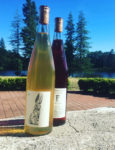 My road to discovering Aaron and Cara was through a bottle of their 2016 The Pearl Thief that I happened on at Chambers Street Wines in TriBeCa where I live. An intriguing Sauvignon Blanc/Viognier blend. (See all details in Deconstructing note at end.)
My road to discovering Aaron and Cara was through a bottle of their 2016 The Pearl Thief that I happened on at Chambers Street Wines in TriBeCa where I live. An intriguing Sauvignon Blanc/Viognier blend. (See all details in Deconstructing note at end.)
I fell for it hard. An unrepentant addict to the quiet murmur of restrained skin contact fermentation and overt minerality.
The bottle registers on that rare scale where natural wines can be at once both interesting and intellectual yet satisfying. A bit inscrutable to boot.
I kept going back to Chambers Street and buying another bottle, then another. Weighing it in my hands, staring at the unique label, and talking with friends at the shop. In awe of how it all works together so well.
As is often with new wine discoveries, I find a bottle with a big hidden aha, connect, write about it and get to know the producers. They, more than the variety or the vintage, become the center of gravity for grasping what I drink.
There is an old adage that wine is made by hand and the product of people with intent and restraint, not nature alone. So it is with Aaron and Cara.
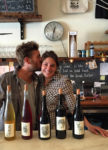 I just naturally liked them.
I just naturally liked them.
Young (he 36, she 29), smart, educated, opinionated without a hint of bravado. Urban East coasters who found each other in DC and wandered West to farm and discovered inspiration in a bottle of wine and the friendship of great producer along the way.
They are intuitive and open thinkers who embrace their youth while respecting the knowledge of those they are learning from. Admittedly lucky to have stumbled into a mentor like Gideon who has the soul of an artist, the work ethic of farmer, a minimalist sculptor’s point of view coaxing something personally unique in the face of such a distinctive and powerful terroir.
Aaron and Cara are just getting started with wine, on their third vintage, focused on the details of the year-round process and the bonds of their relationship as co-vigneronnes, farmers and life partners. Truely hard working, lovely folks.
They described their winemaking to me as a perpetual conversation between the two of them, a personal relationship to the vines, the joy of the backbreaking work in the vineyards, the lure of wine as a way to share their place with others and the openness to doing things in their own way.
By what just feels right and unafraid to fail.
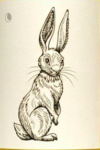 I was drawn to the poetic mythologizing of their journey through their choices–the why of their domaine name, the storied yarn behind each cuvee’s moniker, the elegance of the labels created by Kelly Patton, an artist friend with a plan to evolve the art as a project adding color to the line drawings as the wines develop over the years.
I was drawn to the poetic mythologizing of their journey through their choices–the why of their domaine name, the storied yarn behind each cuvee’s moniker, the elegance of the labels created by Kelly Patton, an artist friend with a plan to evolve the art as a project adding color to the line drawings as the wines develop over the years.
They are certainly natural winemakers with strong beliefs (and Olive Oil makers as well) but there is a lack of dogma here that leaves everything a bit down home. This is refreshing, as are their wines.
I just really enjoyed chronicling this story.
Getting to know them a bit. Having the depth of enjoyment of drinking a number of bottles of The Pearl Thief grow over the week of talking with them and writing this post.
I strongly recommend this bottle from this unique, out-of-the-way spot with awesome defining terroir made by this young and just unabashedly honest winemaking couple. Available from Chambers Street Wines for $30.99.
Their red cuvees and rose are in the market but a bit hard to find at times. Contact David Bowler Wines who distribute them into NY along with Clos Saron for assistance. Ask for Alex Miranda and tell him I sent you.
Big thanks to Aaron and Cara for sharing their story. To Ariana Rolich and the Chambers Street team who bear with me incessantly on a daily basis for years.
*Photos are from Cara and Aaron. The one at the top of the post is them on Slope 23.
————————-
Notes for the curious.
Frenchtown Farms Chronology
- 2014 Befriended Gideon after tasting his vintage ‘08 Black Pear
- 2015 Moved down the road from Clos Saron and made wine with him through three harvests
- Leased Renaissance Vineyards Slopes 23, 9 and 1
- Produced 1200 bottles, 3 red cuvees
- 2016 Produced 5000 bottles, added a white blend and a rose
- 2017 Produced 700 cases with the same 6 cuvees as 2016.
- The Pearl Thief this harvest is 75% Sauvignon Blanc, 25% Roussanne single vintage from Renaissance Lot 23
Deconstructing The Pearl Thief (2016)
- Grape mix in cuvee
- 60% Viognier, from Bokish Vineyard in Lodi.
- 40% Sauvignon Blanc, from Renaissance Slope 23
- Grapes stomped in open containers, macerated on skins till fermentation started (two days), pressed into neutral oak barrels
- Aged in a puncheon and half barrel for eight months
- 25ppm SO2 at bottling
- First Frenchtown Farms white, 60 cases made
- The Pearl Thief name refers to the wild hares that pilfered grapes overnight on Slope 23
- Wine is a beauty–Irresistibly fresh and flavorful. Tangy acidity. Layered acidity on finish
- 2017 vintage
- Approx.125 cases, still in barrels
- Single vineyard 75% Sauvignon Blanc and 25% Roussanne from Slope 23
I could have titled this post arnoldwaldstein.com/wine redux?
Truth be told I’ve been overtly lackadaisical about my relationship to the natural wine world.
Vacillating for awhile on whether it is time re-up my game, put in the time and start to blog again, a passion of mine for almost 10 years straight.
Blogging–and the push into my community project theLocalSip–was a critical piece of who I was back then.
Not an avocation but assuredly a defining part of myself. A visceral connection to a community I grew up with. A bond over an ethical approach to taste, agriculture, the food chain, health and wellness, and the environment alongside my work in tech and community building.
Or simply—on a perfect day, we would all like believe that we are what we believe in beyond the crush of life –and this was one way of making that partially true.
Natural and artisanal wine is at its core a social experiment, not just an agricultural one. That is what captured my imagination from day one and made it all a bit meta and magical.
It is also by definition an impossible economic endeavor. If you define a product as being hand-made, in this case hand-harvested, it by nature unscalable as a business in today’s world.
Yet hundreds of people make this their life. They are buying high, selling low and completely content with it.
That innate wonder and friction wrapped in goodwill and back breaking work in the face of a digital world is what draws me in. It happens in spite of this all.
The truth is that today, more and higher quality wine is being made in this fashion than ever before. A renaissance of sorts without a platformed community or a core social center.
Yet micro blogging brings more ennui than story, more image than thought to this world and I think a disservice to the nuances that make it so special.
I find that with all above being true, there is still a huge gap in the content being produced and the growing captivation with this mushrooming social and agricultural experiment. And personally, I am more enthused when I write about it then when I read what is written. This is the face of the true fact that I have many friends who are outstanding journalists who write with great passion and knowledge in the field.
So—
I’m making this public announcement to myself to start to explore again how to tell some of these stories.
I’ve decided to start slow and on a weekly or biweekly process, pick people making wine that captivates me that I can add my voice to. I’m content defining myself as a blogger with a community rather than a journalist or wine writer, which I’m most certainly not.
The first post will be an interview with Aaron and Cara Mockrish of Frenchtown Farms.
A truly charming and brilliant couple making wine uniquely their own way. They are possibly one of the first of the second generation of NA natural winemakers learning their craft as apprentices to none other than our friend Gideon Beinstock at Clos Saron.
I have some asks for my community.
First is that I am interested in referrals to people that I should interview and blog about. I have a list but it will be better if it grows with your input.
Second is a polemic I’m having with myself about the positioning of—whatever I end up–calling this.
Historically www.arnoldwaldstein.com/wine is my place for wine.
I’m toying around with either moving the wine blog (or whatever it becomes) to reify theLocalSip brand with all of its online properties. Or potentially to unearth the DowntownWineGuy moniker that I’ve sat on for a long time. That is in effect who I am.
Or leave as is. If you have thoughts on this, I’m all ears.
So—thanks for listening to this overindulgent note to myself.
Share what you care to and hope you will join me as I again stumble forward into the passion of mine.


 Part Rudolph Steiner romantic, part viticulturist, part dreamer of a wine culture driving sustainable agriculture in the high desert of Utah. And part, mellowed spiritualist stemming from his Catholic and Evangelical upbringing.
Part Rudolph Steiner romantic, part viticulturist, part dreamer of a wine culture driving sustainable agriculture in the high desert of Utah. And part, mellowed spiritualist stemming from his Catholic and Evangelical upbringing. My connection to this saga, started with a bottle of Evan’s Chilion that I bumped into at
My connection to this saga, started with a bottle of Evan’s Chilion that I bumped into at  He shared the tale of the Cortese grape, the grape variety in the bottle of Chilion.
He shared the tale of the Cortese grape, the grape variety in the bottle of Chilion. How loving this variety, taught him that patience is the pulse of nature, that perfection is an abstraction, that while knowledge is key to decision making, we need be open and leave room for the mystery of it all.
How loving this variety, taught him that patience is the pulse of nature, that perfection is an abstraction, that while knowledge is key to decision making, we need be open and leave room for the mystery of it all. He chose the lounging, inebriated bear on the label of Chilion as an icon with folklorish purpose. How at the Fox Hill Cortese vineyard in Mendocino where the grapes are grown, before they put up deer fences, it was thought time to pick when a bear ambled by, swiped and gorged on the fruit indicating with a natural gesture, that it was time for the harvest
He chose the lounging, inebriated bear on the label of Chilion as an icon with folklorish purpose. How at the Fox Hill Cortese vineyard in Mendocino where the grapes are grown, before they put up deer fences, it was thought time to pick when a bear ambled by, swiped and gorged on the fruit indicating with a natural gesture, that it was time for the harvest that captures the creaminess of the grape, the grip of the skin. A texture and vibrancy that stay with you long after the glass is empty.
that captures the creaminess of the grape, the grip of the skin. A texture and vibrancy that stay with you long after the glass is empty. 012 and made 300 cases, growing grapes in two vineyards in Mendocino. Partnering with his buddy Sam Bilbro from
012 and made 300 cases, growing grapes in two vineyards in Mendocino. Partnering with his buddy Sam Bilbro from  A big thank you to Evan for his patience in chatting with me. To my good friend
A big thank you to Evan for his patience in chatting with me. To my good friend 
 These qualities are singularly true for Cameron and Marlen Porter, co-winemakers and the couple behind
These qualities are singularly true for Cameron and Marlen Porter, co-winemakers and the couple behind  fresh and bright, light and brilliant bottle that drinks like an homage to my beloved Poulsard from the Jura.
fresh and bright, light and brilliant bottle that drinks like an homage to my beloved Poulsard from the Jura. There is something original, honest, solidly earnest and focused about the two of them.
There is something original, honest, solidly earnest and focused about the two of them. diverse terroir. Poetic as they describe how the transverse mountain ranges, opening to the pacific drive huge temperature shifts impacting the vines. How the uniqueness of the soil—serpentine and diatomaceous earth–is formative to the character of the place and the possibilities of the wine itself.
diverse terroir. Poetic as they describe how the transverse mountain ranges, opening to the pacific drive huge temperature shifts impacting the vines. How the uniqueness of the soil—serpentine and diatomaceous earth–is formative to the character of the place and the possibilities of the wine itself. I can’t recommend these wines enough.
I can’t recommend these wines enough. I so enjoyed getting to know the family and chronicling this story.
I so enjoyed getting to know the family and chronicling this story.

 My road to discovering Aaron and Cara was through a bottle of their 2016
My road to discovering Aaron and Cara was through a bottle of their 2016  I just naturally liked them.
I just naturally liked them. I was drawn to the poetic mythologizing of their journey through their choices–the why of their domaine name, the storied yarn behind each cuvee’s moniker, the elegance of the labels created by
I was drawn to the poetic mythologizing of their journey through their choices–the why of their domaine name, the storied yarn behind each cuvee’s moniker, the elegance of the labels created by 